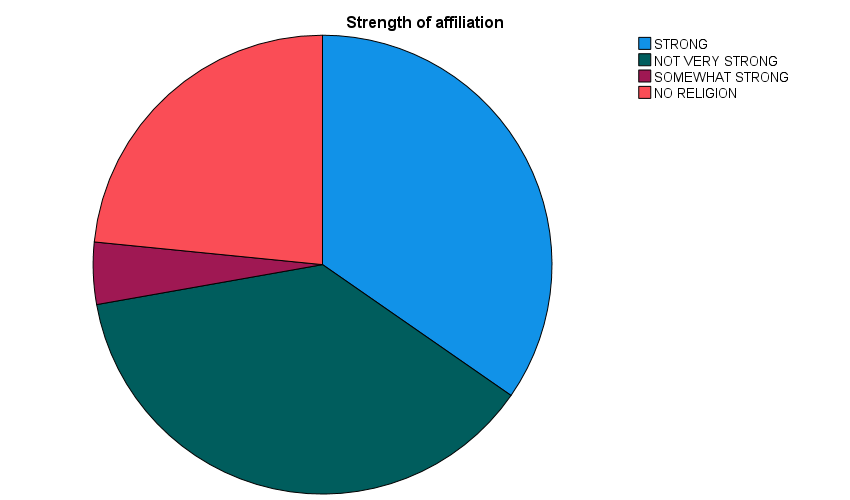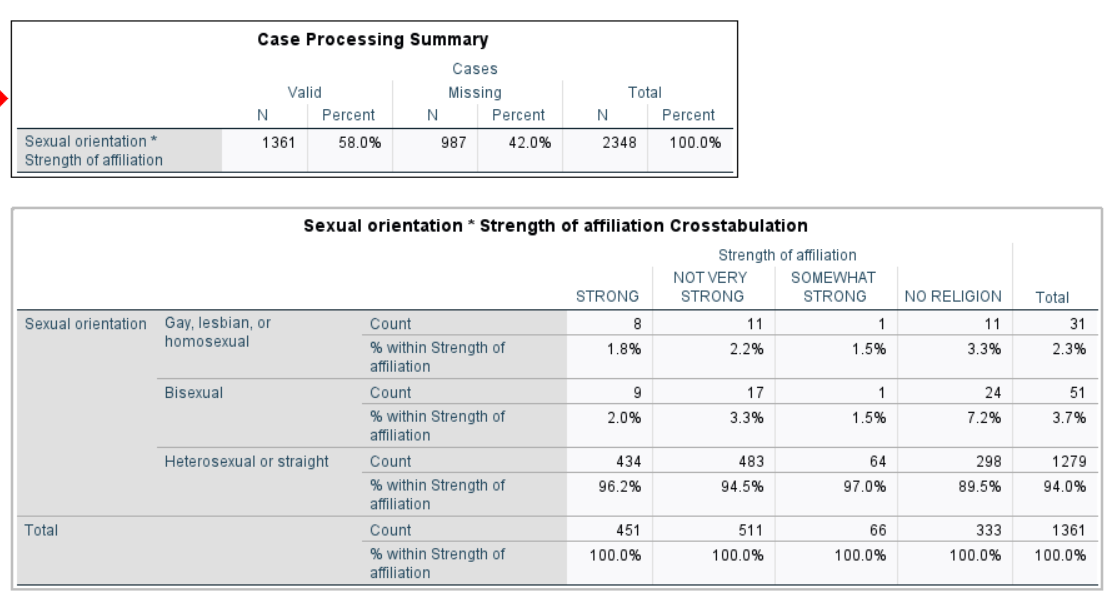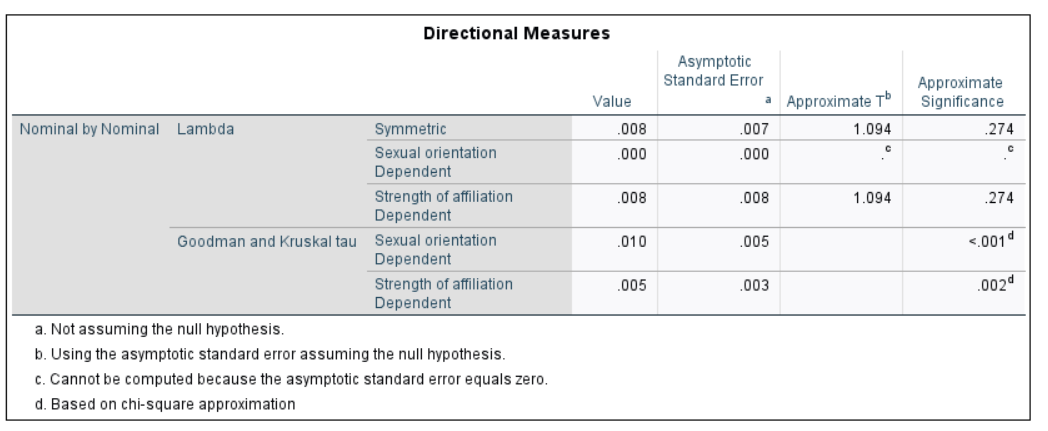Introduction
The notions of religion and sexuality continue to be some of the most sensitive topics for discussion in modern society. According to the researchers, “religion and religiosity play an important role in the sexual behaviors of young people” (Somefun, 2019, p. 1). Indeed, the stigma that surrounds the interrelationship between one’s religious affiliation and sexuality implies that a strong religious impact on the individual, along with the social environment, tends to interfere with the person’s self-awareness and sexual identification. For this reason, it would be of paramount importance to dwell on the scope of correlation between one’s religiosity and sexuality. The research question of the present study is as follows: “What is the correlation between one’s religious affiliation and sexuality?” The research hypothesis states that there is such a correlation. The research is expected to shed light on the implication and the scope of religion’s influence on one’s sexual identity.
Literature Review
Nowadays, many researchers place emphasis on the complicated relationship between religious values person’s acceptance of their sexuality. Thus, the study by Somefun et al. (2019) addresses the impact of religion on the sexual abstinence of sub-Saharan Africa’s young people. The cross-sectional study was conducted among the unmarried male and female Nigerian population aged 15-24 (Somefun et al., 2019, p. 3). The sample of 2,339 young adults was comprised of Christians, Catholics, and Muslims, with more than 88% of the sample identifying them as highly religious (Some fun et el., 2019). The findings revealed that young people who described themselves as highly religious were nearly two times more likely to abstain from sex (Somefun, 2019, p. 6). This study provides significant value to the topic of research, as it explicitly demonstrates that religion as a cultural phenomenon explicitly shapes the sexual behavior of many young adults.
Another study by Hinman and Lacefield (2020) dwells on the phenomenon of the interrelation between gay men and their conservative Christian upbringing. One of the primary hypotheses of the study is that “men who were raised in a conservative, evangelical Protestant church and who also identify as gay, likely will have difficulty reconciling their church’s position toward them and their position toward sexuality” (Hinman & Lacefield, 2020, p. 2). The phenomenological study aimed at conducting semi-structured in-depth interviews with seven gay men raised as Seventh Adventists. The findings revealed that every participant in the study suffered from the challenges of self-identity, so in order to embrace their sexuality, they needed to reconsider their relationship with conservative religious dogmas (Hinman & Lacefield, 2020). This qualitative study demonstrates how religious background affects one’s sexual identity when it comes to terms of self-identity, demonstrating a strong correlation between the variables.
A study by Lefevor et al. (2020) focuses on the relationship between the well-being of Black minority communities and potential psychological stressors. The study reveals two major findings of the Black minority community and religious affiliation. First, more than 80% of the community is religiously affiliated, and many representatives of the minority find support from the religious community (Lefevor et al., 2020). Simultaneously, however, the church itself frequently promotes rather homophobic narratives and implicitly encourages its members to conceal their sexual identity. The researchers conclude that “religiousness may operate in a supportive way for Black sexual minorities, contrary to how religiousness is portrayed for sexual minorities generally” (Levefor et al., 2020, p. 12). The study provides a valuable perspective on how the correlation between religious affiliation and sexuality is not inherently negative.
Finally, the evidence presented in the book by Shah (2018) revolves around the experiences of the gay community in Malaysia and Britain as contrastive religious and social environments for the LGBTQ+ community. The text presents both historical backgrounds of the Islamic countries’ relationship with religion and the unique experiences of gay Muslim men. One of the valuable outputs from the book emphasizes that Islam as a religion does not condemn homosexuality, whereas the social interpretations of religion put pressure on embracing one’s sexual identity (Shah, 2018). Hence, this piece provides value by incorporating the social perception of religion as an important mediator between sexuality and spiritual teachings.
Dataset
For this research, the General Social Survey (GSS) data were collected in two primary ways. The raw research data was collected through face-to-face interaction and interviews with the participants. The participants were chosen randomly across the state regardless of age, gender, or ethnic background, but all the background data was collected during the interview. The inclusion criterion was the respondents’ proficiency in English and Spanish languages. The National Science Foundation funds the present study. The two variables, including religious affiliation and sexuality, were examined in 2020. The data were collected with the help of interpersonal interaction via phone and video-conferencing platforms such as Zoom and Skype.
Variables
Since the central research question addresses the correlation between religious affiliation and sexuality, it was necessary to establish the extent to which one’s religious affiliation affects sexuality. Hence, the independent variable (IV) of the study is religious affiliation. The question for the respondent is as follows: “Would you call yourself a strong (preference named in religion) or not very strong (preference named in religion)?” The answer categories vary on a 4-level scale: “strong, not very strong, somewhat strong, no religion.” The level of measurement is nominal. The dependent variable (DV) of the study is sexuality. The question for the respondent is as follows: “Which of the following best describes you?” The answer categories are “gay, lesbian, or homosexual,” “bisexual,” and “heterosexual or straight.”
Findings
Out of the population sample, most IV categories were “strong” and “not very strong,” constituting 802 and 849 respondents, respectively. Since the response rate was high, it can be concluded that the majority of respondents felt rather strongly about their religious affiliation, with 23% of the respondents demonstrating no religiosity. As far as the DV is concerned, the response rate of 58.5% distorts the reliability of the data. Simultaneously, a higher percentage of missing responses indicates that people feel more comfortable talking about religion rather than their sexual identity. Out of the valid responses, 94% of the sample identified themselves as straight, 3.7% claimed to be bisexual, and the rest chose a “gay or lesbian” category.
The crosstabs and measures of association for the response rate demonstrate that whereas there is a high level of correlation between IV and DV, knowing one’s sexual identity or religious affiliation cannot help identify the categories of other variables. The test of significance for the study leads to the following conclusion:
- Since 0.005 < 0.05, then the null hypothesis shall be rejected. After conducting this analysis, one can assume a strong correlation between one’s sexual orientation and religiosity.
Thus, the findings of the study demonstrate that despite the lack of an explicit causal relationship between racial affiliation and sexuality, the correlation of the variables demonstrates their interdependence. Based on the literature review, one can assume that such a correlation is driven by the religion’s impact on attitude toward sexuality and the issue of self-awareness. Presumably, people with strong religious affiliations shape their view of sexuality based on spiritual teachings and their upbringing.
Table 2. Response Frequency Table for Sexual Orientation Survey


Findings: Copy & Paste corrected analyses from Weeks 3-6, i.e., Crosstabs, Measures of Association, Tests of Significance. Include the five steps of hypothesis testing.

Based on the data demonstrated during the statistical analysis, it has become evident that many individuals who identify themselves as heterosexual (96,2%) have a strong sense of religious affiliation. Conversely, almost half of bisexual people (24 out of 51 respondents) claim to have no religious affiliation whatsoever. After calculating epsilon, the differences between the highest and the lowest values in the row are as follows: 94.4%, 92.3%, 95.5%, 86.2%. The principle of epsilon implies that the differences higher than 10% demonstrate a strong correlation between the two variables. In the case of the present analysis, the value is significantly higher than 10%. Since both Variables are nominal, their direction cannot be determined.
Measures of Association (30 pts)
After reviewing the guidelines and the required reading this week, I have determined that both of my variables, IV: RELITEN and DV: SEXORNT, are nominal variables. Therefore, I created a LAMBA correlation test. According to the LAMBDA test, knowing someone’s (DV: SEXORNT) Sexual Orientation will reduce our error in predicting their religion by 0%. Analyzing the data below, the variable’s value appears to have a weak relationship.

Test of Significance on Project Variables (25 points)
- State your research hypothesis (H1) and null hypothesis (H0).
Hypothesis (H1): There is a strong correlation between one’s sexual orientation and religious affiliation.
Null Hypothesis (H0): There is no correlation between one’s sexual orientation and religious affiliation.
- Identify your significance level (alpha) at.05
- Conduct your analysis using SPSS.

Conclusion
The findings of the present statistical analysis provide empirical evidence to the issue of relation and sexuality interrelation. For many years, the “religion-sexuality” paradigm has been questioned by scholars, as it is generally known that spiritual dogmas do not condone homosexuality as a socio-biological phenomenon. The justification of the correlation hypothesis contributes significantly to the idea that the representatives of sexual minorities have a weaker attribution to religion. Indeed, out of the respondents who identify themselves as homosexual or bisexual, most relate to either “no religion” or “not very strong” religious affiliation.
The study has a series of limitations because it does not account for potentially crucial variables mentioned in other scholarly studies. These variables include ethnic affiliation, denomination, and family background. In future studies, the present data can be used to expand the scope of research and include these variables to make sure that more information on the nature of correlation is revealed. Another limitation is a low level of minority representation and incoherent response rates. In future studies, the researchers can use convenience sampling to work closely with minority groups and their relationship with religion. Nevertheless, the present research study creates a solid foundation for further investigation of sexuality and religion among various social groups.
References
Hinman, B. K., & Lacefield, C. (2020). There is an exploration of spirituality and sexuality in men who identified as gay and were raised in a conservative Christian faith. Journal of Research on Christian Education, 29(2), 156-175. Web.
Lefevor, G. T., Smack, A. C., & Giwa, S. (2020). Religiousness, support, distal stressors, and psychological distress among black sexual minority college students. Journal of GLBT Family Studies, 16(2), 148-162. Web.
Shah, S. (2018). The making of a gay Muslim: Religion, sexuality and identity in Malaysia and Britain. Palgrave Macmillan.
Somefun, O. D. (2019). Religiosity and sexual abstinence among Nigerian youths: Does parent religion matter? BMC Public Health, 19(1), 1-11. Web.